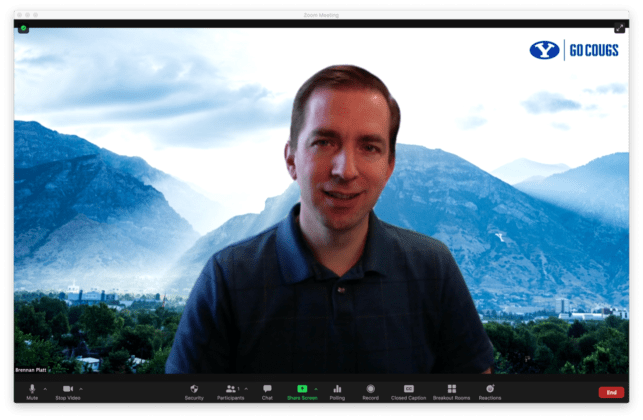BYU professors have taken a liking to virtual Zoom backgrounds as a new way to engage students and as an opportunity to innovate teaching styles.
The backgrounds range in themes from “Harry Potter” to nature scenes — even toilet paper rolls have been featured.
Seven BYU professors shared their favorite virtual Zoom backgrounds: Daniel Smalley, Steve Nelson, Craig Harline, Brennan Platt, Sarah Agate, Xinru Page and Perla Escobar.
BYU electrical engineering professor Daniel Smalley said he uses virtual Zoom backgrounds to foster creativity. As a professor who encourages students to use their engineering skills in “Star Trek” simulations in his electromagnetics class, Smalley loves having fun in academics.
He has used themes like kung fu, “Harry Potter,” “Star Wars” and many more for his virtual backgrounds.
“I like virtual backgrounds; anytime there’s an opportunity to switch things up and use creativity, it’s really helpful in many ways,” he said.
Smalley has also used virtual backgrounds in more professional settings, like conferences. He uses a virtual background that has a timer pop up to non-verbally signal when time is running out during presentations.
BYU environmental geology professor Steve Nelson said he enjoys using geographical-themed virtual backgrounds while teaching his students about different types of soils, bodies of water and other parts of the planet.
Students seem to have different opinions on the Zoom backgrounds, considering factors like the style of background and whether it’s professors or students using them.
Chandler Rogers, a junior studying product management, said he thinks virtual backgrounds can detract from the professionalism of a professor’s lesson or a student’s presentation.
“If professors use a virtual background, I would definitely just suggest using a more professional one or one that’s not too distracting. When students use virtual backgrounds, the signal it sends to me is that people aren’t super engaged,” Rogers said.
Rogers, who goes to school primarily online and has been working virtually long before the pandemic hit, said he understands professors have made a big transition from teaching face-to-face to Zoom.
Matt Jensen, a junior studying information systems, has personally used virtual backgrounds in Zoom meetings with peers and said he thinks there’s a time and place where they can be used in an entertaining or purposeful way.
“I think virtual backgrounds can serve as an anti-distraction mechanism,” he said.
Jensen said he enjoys virtual backgrounds because they help him focus on the speaker because of how entertaining or interesting they can be. Without virtual backgrounds, he’s seen clutter in people’s rooms and offices or people walk behind students while they’re speaking.
Jensen said it’s generally clear when it’s appropriate to use a virtual background and that the backgrounds allow others to see the personality of those using them.














